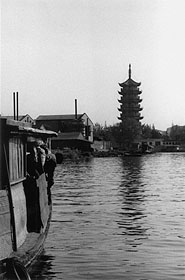History and Milieu (7)

Four hundred years of Yangzhou storytelling
The present website is concerned mainly with the storytelling from Yangzhou, one of the places in China where storytelling of the pinghua type has a very long and glorious history. Yangzhou is an old town in Jiangsu province, situated in the Lower Yangzi area, between Shanghai and Nanjing. At this place the Grand Canal, artificially created to serve transportation between south and north China, opens into the Yangzi River. This was formerly a key position for communication and commerce. Since the Tang and Song periods, Yangzhou’s position at the junction of the main waterways, helped the town to become one of the major administrative centers of China. The economic situation of the town and the countryside were supportive for the entertaining arts, such as storytelling.
During the Ming dynasty Yangzhou became one of the most important cultural and commercial centres of China, based on its administration of the salt monopoly, its strategic position for waterway communication, and its rich traditions in handicraft. From the end of the Ming dynasty, storytelling grew immensely popular in the milieu of well-to-do merchants and shopkeepers.
From the end of the Ming period we have historical sources that mention names of storytellers from Yangzhou and their repertoires, such as ‘Water Margin’, ‘Three Kingdoms’ and other tales. Storytellers of reputation are mentioned in topographical works from the 18th century. From the beginning of the 19th century we have detailed accounts about the various ‘schools’ or lineages of storytellers from the area. The storytellers who told ‘Water Margin’ and ‘Three Kingdoms’ belonged to large ‘schools’ with many ramifications, ultimately going back to four honorable masters from the beginning of the 19th century. During the early years of the Republic (1911-1949) a new oral saga was created in Yangzhou storytelling, taking its theme from the ‘Journey to the west’, another famous Ming novel with early oral-related prototypes. The three themes of ‘Three Kingdoms’, ‘Water margin’ and ‘Journey to the West’ represent a universe of fact, fiction and fantasy that is most beloved among the Chinese. On this website, Sagas of storytelling, you will find extracts told by the Yangzhou master tellers of our time.
At the time of the 1911 revolution, storytelling was at a high tide. There was a great demand for this kind of entertainment where political comment on the issues of the day might often be interspersed into the traditional tales in a humorous way of double-entendre. The first half of the twentieth century brought the folklorists attention to the art. A vast effort, backed up by government aid during the 1950s, was made to preserve the storytellers’ repertoire in printed books for the general reader. On the other side, the preservation of the oral art as such was given scanty support, and periodically the storytellers’ life conditions were outright neglected. From the 1960s to the 1980s many performers were driven out of their profession and had to find other occupation.
The earlier system of mutual cooperation between teahouse owners and storytellers in attracting the public was heavily undermined during the 1960s. State ownership of the performance arenas meant, more often than not, closing down of the former entertainment places. During the Cultural Revolution 1966-76 the storytellers’ traditional repertoires were strictly banned and many performers persecuted.
During the last twenty years new possibilities have opened up. But at the same time the storytellers are now confronting what seems to be the greatest challenge of the oral arts: the modern media world. In order to attract their audience, they must compete not only with the modern electronic media, but they must adapt somehow to the changing habits and lifestyle of the modernized country. The storytellers have been able to survive into the new millenium. Will they survive in the new society? The last word has not been said on this question.
Yangzhou town video (mpeg 6.925Kb)
Yangzhou town video (wmv 2.136Kb)